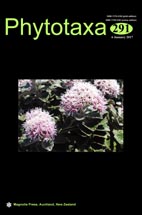Abstract
Eriope harleyi and E. paradise, two new plant species from central Brazil, are described and illustrated. Eriope harleyi is similar to E. crassipes, but differs in the presence of ovate or orbicular leaves, leaf size (1.8–2.5 × 1.2–1.8 cm), length of petiole (0.15–0.35 cm), presence of bracteoles in the pseudopedicel base and marginal vein fimbriate in E. harleyi (versus lanceolate-elliptic leaf, leaf size (4.0–7.5 × 1.5–3.5 cm), length of petiole (0.50–1.50 cm), and the absence of bracteoles in the pseudopedicel base and marginal vein in arches). Eriope paradise is similar to E. complicata but this new species does not have prominent tertiary veins on its abaxial surface nor bracteoles in the pseudopedicel base, and has inflorescences forming a monothyrse (versus prominent tertiary veins in abaxial face, presence of bracteoles in pseudopedicel base and inflorescence in diplothyrse). Presence of a hypoderm, stomata on both faces of the leaf epidermis, and straight or sinuous contour of the anticlinal walls of leaf epidermal cells are all examples of characteristics of leaf anatomy used for the establishment of this new taxa. Data about the habitat, phenology, conservation status, and geographic location are also presented.

